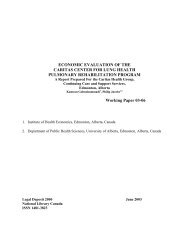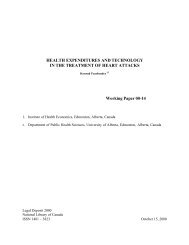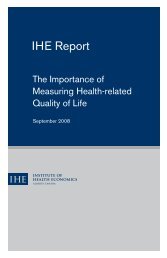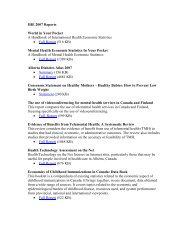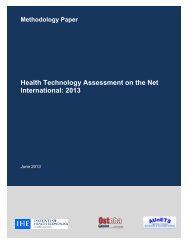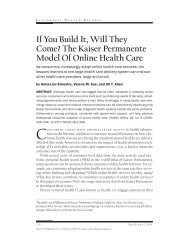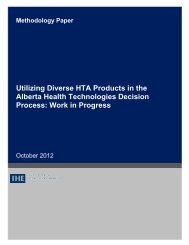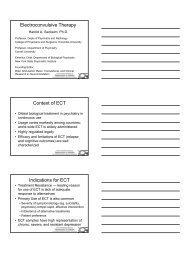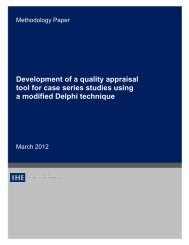Bariatric treatments for adult obesity - Institute of Health Economics
Bariatric treatments for adult obesity - Institute of Health Economics
Bariatric treatments for adult obesity - Institute of Health Economics
- No tags were found...
You also want an ePaper? Increase the reach of your titles
YUMPU automatically turns print PDFs into web optimized ePapers that Google loves.
Table T.F.1-1: Weight loss Dietary therapy/physical exerciseSRs/HTAsGalani & Schneider, 2007 56Prevention studies:N <strong>of</strong> trials: four, high quality studiesN <strong>of</strong> patients: 1168; mean BMI 27kg/m 2Treatment studies:N <strong>of</strong> trials: five, high qualityN <strong>of</strong> pts: 3032; mean BMI 33 kg/m 2Shaw et al., 2006 57N <strong>of</strong> trials: 41N <strong>of</strong> patients: 3476, overweight(BMI >25 kg/m 2 ) or obese (BMI ≥30kg/m 2 )Curioni & Lourenco, 2005 58N <strong>of</strong> trials: sixN <strong>of</strong> patients: 514; BMI unknownWeight loss (WL)Lifestyle interventions versus standard care (not defined)Weight (kg): MD 3.1(P = 0.0001) (prevention studies); MD 5.1 (P < 0.0001) (treatment studies)BMI (kg/m 2 ): NA in prevention studies; MD 1.8 (P = 0.001) (treatment studies)Exercise (E) versus no treatment (12 trials)Weight (kg): exercise increased WL compared to no treatment. E: 0.5 to 4.0 versus no treatment: 0.1 to +0.7BMI (kg/m 2 ): exercise reduced BMI more than no treatment. E: 0.3 to 0.7 versus no treatment: +0.3 to +0.4E versus diet (D) (10 trials)Weight (kg): Diet resulted in greater WL as compared to exercise. E: +0.5 to +4.0 versus D: 2.8 to 13.6BMI (kg/m 2 ): Diet resulted in greater reduction in BMI as compared to exercise. E: 0.3 to 0.8 versus D: 0.3 to 3.3E+D versus D (17 trials)Weight (kg): E+D resulted in greater (1.1 kg more) WL as compared to D alone. E+D: 3.4 to 17.7 versus D: 2.3 to 16.7BMI (kg/m 2 ): E+D resulted in greater (0.4 kg more) reduction in BMI as compared to D alone. E+D: 0.6 to 4.0 versus D: 0.3 to 4.0High-intensity E versus low-intensity E (eight trials)Weight (kg): increasing the intensity <strong>of</strong> exercise increased the weight loss if participants were not on a diet; high-intensity exercisers lost 1.5kg more than low-intensity exercisers; high-intensity E: 1.3 to 8.9 versus low-intensity E: 6.3 to +0.1BMI (kg/m 2 ): insufficient data <strong>for</strong> analysisHigh-intensity E versus low-intensity E with D (8 trials)Weight (kg): increasing the intensity did not increase the weight loss if participants were on a dietBMI (kg/m 2 ): same as aboveWeight loss: individuals in the diet plus exercise group had a mean WL after intervention approximately 20% greater than individuals inthe diet group: –13.0±10.4 kg versus –9.9±9.6 (P = 0.063)Weight maintenance: individuals in the diet plus exercise group had a mean WL after 1 year approximately 20% greater than individualsin diet group: –0.67±8.3 kg versus –4.5±11.3 (P = 0.058)% WL from baseline: immediately after intervention: –13±5.5% versus –10±3.6%; after 1 year: –6.8±4.1% versus –4.6±2.5%; weightregain after 1 year: –50±8.2% versus 50±5.9%<strong>Bariatric</strong> <strong>treatments</strong> <strong>for</strong> <strong>adult</strong> <strong>obesity</strong> 137



